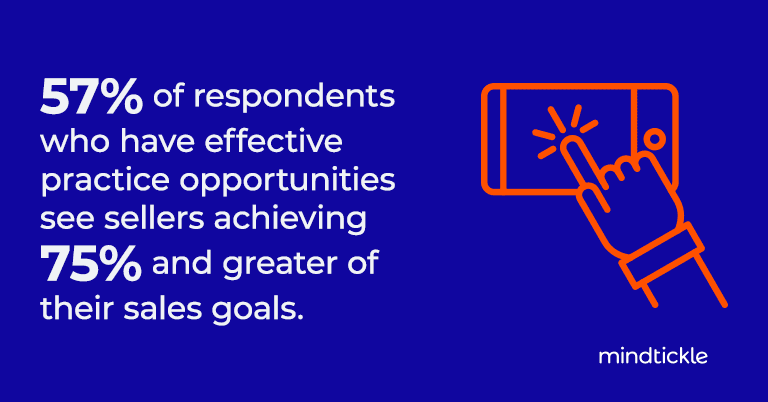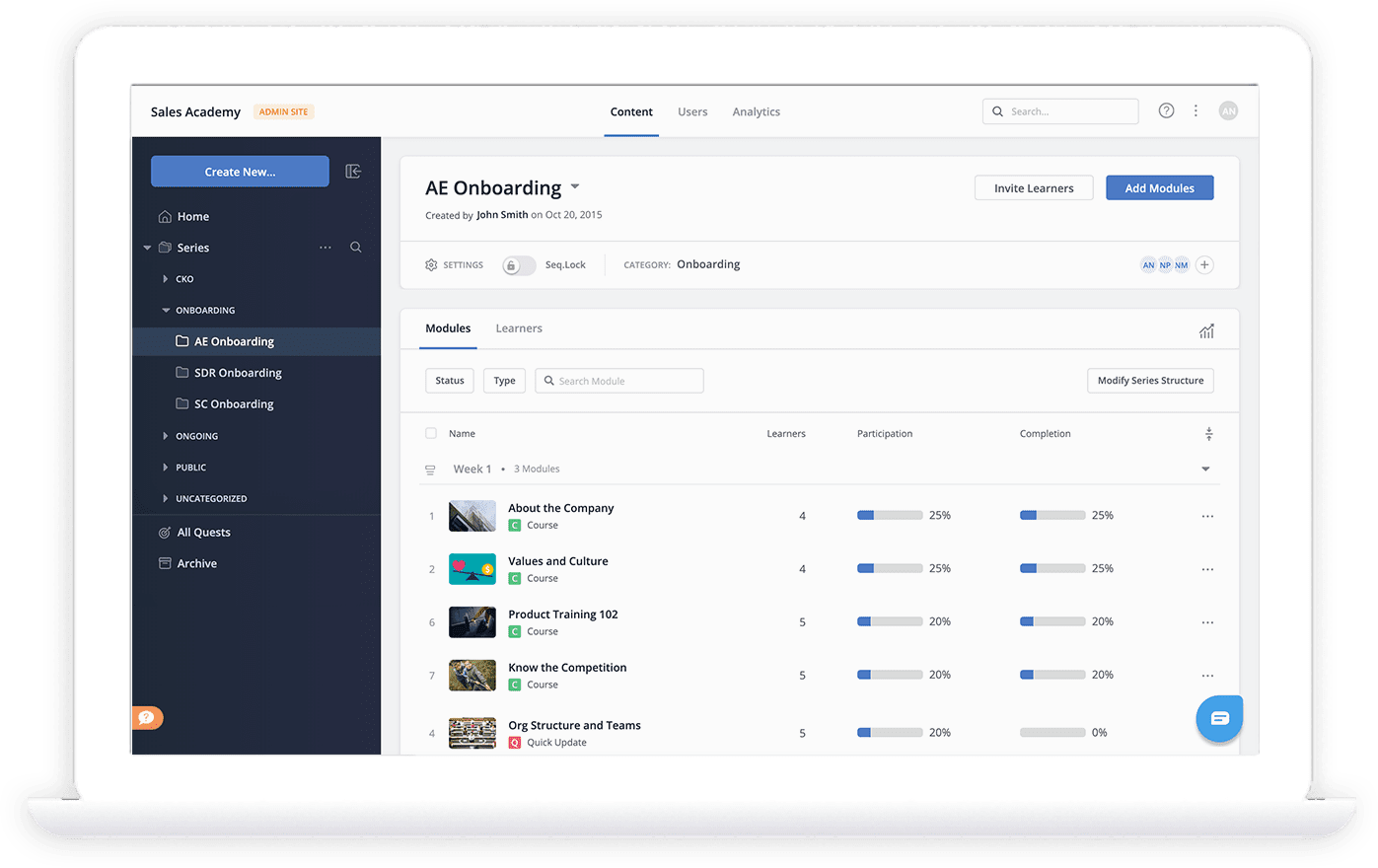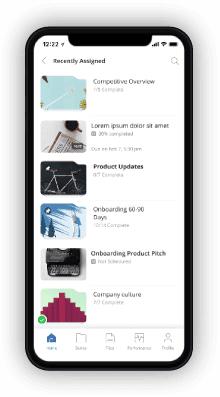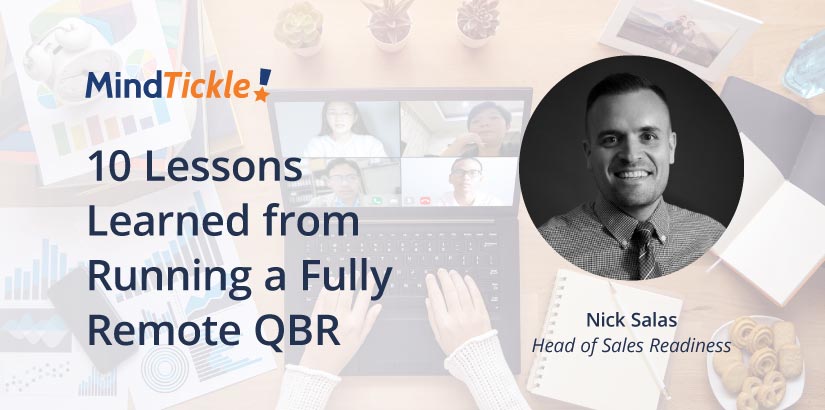5 Hacks From Best-in-Class Sales Readiness Programs
Let’s get the bad news out of the way: across all industries, only 43% of sellers now meet their quota. That means nearly six out of every 10 sellers fail to meet their goals.
Here’s the good news: a comprehensive, data-driven sales readiness approach can help you overcome your key challenges — and empower more sellers to meet (and even exceed) quota.
But not all readiness strategies are the same.
So, what do the best sales organizations do differently to ensure their reps are ready to sell? To find out, we analyzed activity from more than one million users at 350 companies for our 2022 State of Sales Readiness Report.
Based on our key findings, we’ve put together five proven hacks that’ll help you optimize your own sales readiness program and start crushing your sales goals.
Hack #1: Don’t reinvent the sales enablement wheel
Sales enablement is an essential component of an effective sales readiness strategy. And because key aspects of selling are always changing, enablement teams must go beyond onboarding (in favor of what we at Mindtickle refer to as sales everboarding) to deliver ongoing training and just-in-time content to ensure sellers understand these changes and internalize them.
But preparing new onboarding or ongoing training content requires a big investment of time. On average, it takes six weeks to launch a new program from scratch.
However, winning organizations launch sales enablement programs a whole lot faster — without compromising quality. What’s their secret? They focus on efficiency by leveraging templates.
Think of program templates as out-of-the-box yet customizable blueprints developed for common sales enablement use cases and based on industry best practices. Some of the most commonly used templates in Mindtickle are for:
- Sales onboarding
- Product training
- Sales processes
Templates eliminate the need to reinvent the wheel each time you launch a new program, which means you can launch programs a whole lot faster. On average, using a template, enablement managers can launch a new program within seven days. That means sellers can consume the learning much earlier — and start applying what they’ve learned to close more deals.

Hack #2: Update key sales content on a quarterly basis
More than 25 years ago, Bill Gates wrote an essay titled, “Content is King.” In 2022, the sentiment is still very true — especially for B2B sellers. Having access to the right content ensures sellers are always ready to close more deals.
Most organizations invest significant time and resources into developing content that helps prepare reps for every selling situation. But, all too often, those same organizations release new content and then don’t give it much thought for months on end. As a piece of content gets stale, seller engagement drops.
However, top sales organizations are making it a priority to regularly update their key content. And our analysis found that new or recently updated content is correlated with better overall engagement.
Don’t mistake content development as a one-time event. Instead, commit to updating your key content on a regular basis to keep seller engagement high.
How often are the best sales organizations updating sales content?
The 10% of organizations that get the highest amount of seller engagement make content updates once every 3.25 months, on average. And they see 4.58 content engagements per seller week. In comparison, organizations that update key content once every 4.5 months see an average of 3.43 content interactions per seller per week.
That means the top 10% of sales orgs are seeing a 33% increase in overall use of sales content. Clearly, regular updates pay off in terms of seller engagement.

Hack #3: Expect resistance from prospects on sales calls — and equip reps to handle it
It’s a simple fact that if a seller isn’t making enough calls, they’re not going to close enough business to meet quota. So it’s probably not surprising that the best sales reps spend a good amount of their time on the phone.
In an ideal world, each of those sales calls would be largely positive, with prospects feeling confident and excited. But that’s not reality.
We analyzed more than 100,000 sales calls and found that negative sentiment outweighs positive sentiment — by a lot. Just over a third (37%) of calls contained positive sentiments (think confidence, analytical discussion, and excitement, among others) than negative sentiments (think anger, uncertainty, disappointment, or tentativeness). The remaining 63% of calls had more negative sentiment than positive.

Sales calls often contain more negative sentiment than positive.
But make no mistake: a negative call isn’t necessarily a lost cause — especially when it’s handled the right way. The best sales organizations train their reps to expect resistance from prospects and equip these sellers to handle it.
Ensuring reps know your messaging and can lead a proper demo is important. But it’s not enough. Be sure you’re also focusing on enablement topics such as objection handling and competitive knowledge. The right enablement can help reps build confidence and turn largely negative calls around to close more deals.
Hack #4: Support sales coaching with follow-up and reinforcement
Sales coaching, when done well, can have a big impact on the success of a seller (and the entire organization). In fact, the power of coaching is proven. Recent research found that eight out of 10 teams with effective coaching practices hit greater than 75% of their sales quotas.
But coaching can’t be a case of one-and-done. A single coaching session, on its own, probably isn’t going to have much of an impact.
The best sales organizations understand that ongoing follow-up and reinforcement is essential to ensure that skills coaching sticks — and those skills are applied when it matters: in the field. In fact, top managers are three times more likely to assign content, training, or a role-play exercise as a follow-up to a coaching session.

The good news is that coaching follow-up and reinforcement are proven to improve a rep’s readiness. On average, there’s an improvement of 13 percentage points in Sales Readiness Index scores for reps who are assigned follow-up actions after a coaching session.
The average improvement in Sales Readiness Index scores for reps who are assigned follow-up actions after a coaching session.
Talking the talk is not enough. After a coaching session, assign self-paced enablement, content to read, role-plays, or other existing resources to reinforce skills and give reps opportunities to practice what they’ve learned. By doing so, you’re sure to boost reps’ overall readiness, as well as their on-call performance.
Hack #5: Document your ideal rep profile
Hiring for fit is a great start. But even the most seasoned sellers need ongoing skill development, reinforcement, and manager-led coaching for long-term success. However, before creating these programs, sales leaders must take a step back to identify exactly what skills reps need to succeed. In other words, they need to develop an ideal rep profile (IRP).
But, more often than not, they don’t take the time to do so. While 93% of companies have documented their ideal customer profile, fewer than 1% have identified and documented a corresponding IRP.

Few organizations document their IRP.
- 93% of companies have documented their ideal customer profile
- Fewer than 1% have identified and documented a corresponding ideal rep profile
This is a big misstep. After all, how can you achieve excellence if you haven’t even defined what it looks like?
The best organizations understand that an IRP is the essential foundation of any winning sales enablement program, and they put in the time to define theirs.
Take a page from their book, and document the skills and competencies needed for sales success at your organization. Then, consistently measure teams and individual reps against the IRP. By doing so, you can shed light on the learning gaps of each rep and be better equipped to deliver learning and coaching that closes those gaps and creates more peak performers.
Benchmark your sales readiness to optimize your strategy
Sales organizations that expect to achieve quota can no longer rely on the Pareto principle — the notion that 20% of sellers generate 80% of sales. Instead, they must work to ensure every seller is ready to close any deal.
But sales enablement alone isn’t enough to prepare sellers. The best sales organizations know they must take a more holistic, data-driven approach to sales readiness.
By benchmarking your sales readiness against that of best-in-class organizations, you’ll shed light on opportunities to improve your own readiness strategy.
Want to learn more about what the most successful sales organizations are doing to ensure all of their reps are always ready to sell? Download the 2022 State of Sales Readiness benchmark report.



 “We’ll see a bigger blend between sales and marketing. In particular, we’ll start to see sales functions taking responsibility for inbound campaigns, which means we’ll see more sales resumes coming through with SEO and PPC certifications.”
“We’ll see a bigger blend between sales and marketing. In particular, we’ll start to see sales functions taking responsibility for inbound campaigns, which means we’ll see more sales resumes coming through with SEO and PPC certifications.” “Effective prospecting and generating demand will be essential skills for sales reps. In addition, the ability to effectively qualify leads will be the most impactful skill to help reps make the best use of their selling time.”
“Effective prospecting and generating demand will be essential skills for sales reps. In addition, the ability to effectively qualify leads will be the most impactful skill to help reps make the best use of their selling time.” “Sales reps without a voice or personal brand on platforms like LinkedIn will find it more difficult to stand out from the pack.”
“Sales reps without a voice or personal brand on platforms like LinkedIn will find it more difficult to stand out from the pack.” “Relationship building will become an increasingly important skill as we shift toward people wanting to build trust and a relationship to enhance the customer experience.” He added, “Sales activity will become more intensely focused on problem-solving — being able to identify the problem the customer is looking to solve and demonstrate how you can achieve it.”
“Relationship building will become an increasingly important skill as we shift toward people wanting to build trust and a relationship to enhance the customer experience.” He added, “Sales activity will become more intensely focused on problem-solving — being able to identify the problem the customer is looking to solve and demonstrate how you can achieve it.” “Some of the most important skills for salespeople will be the ability to understand their customer’s needs and translate them into a solution, and the ability to be able to think on their feet and be able to react to different situations.” He added, “Technology is transforming the way we do business, by giving salespeople the data they need for each scenario.”
“Some of the most important skills for salespeople will be the ability to understand their customer’s needs and translate them into a solution, and the ability to be able to think on their feet and be able to react to different situations.” He added, “Technology is transforming the way we do business, by giving salespeople the data they need for each scenario.”
























